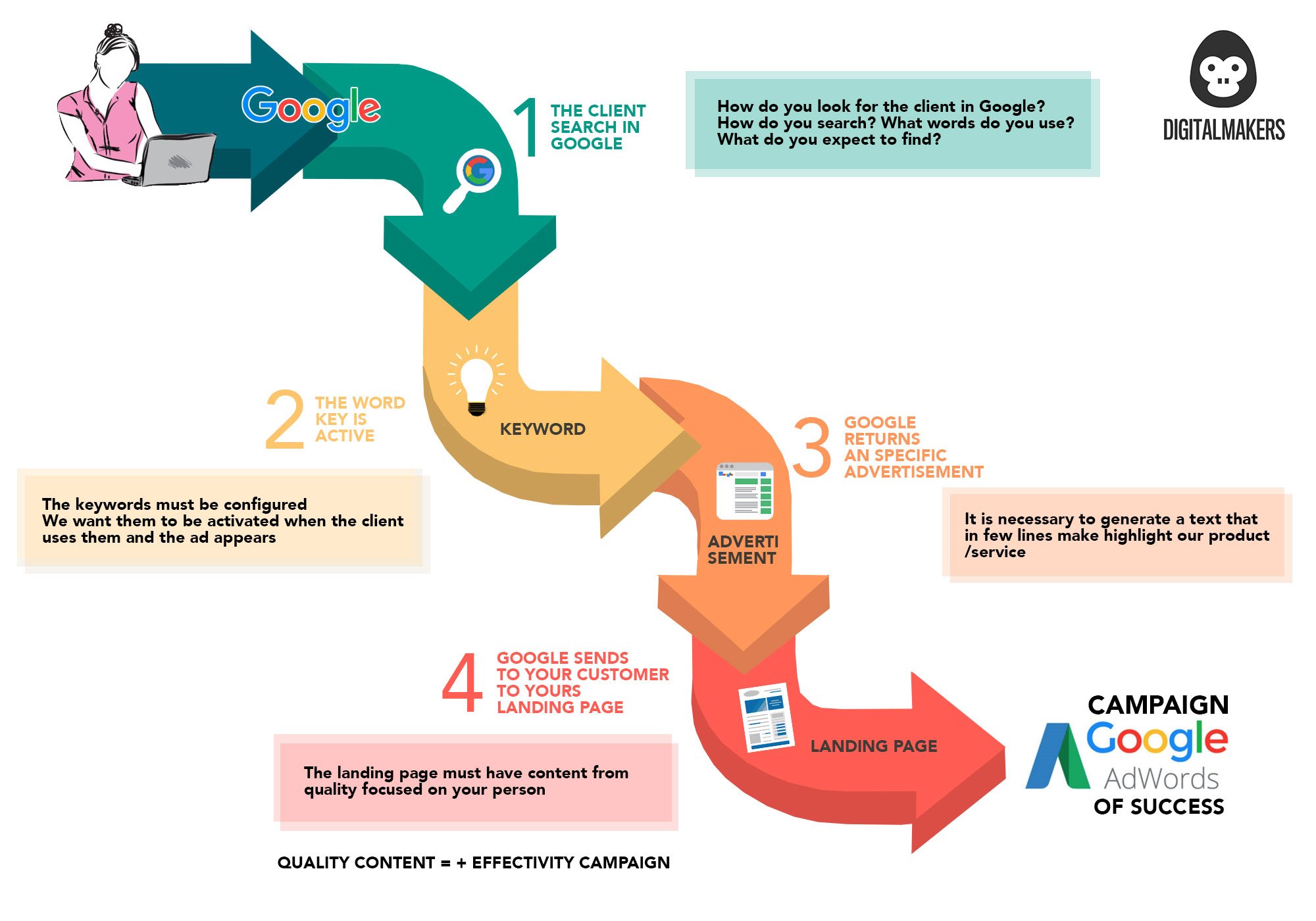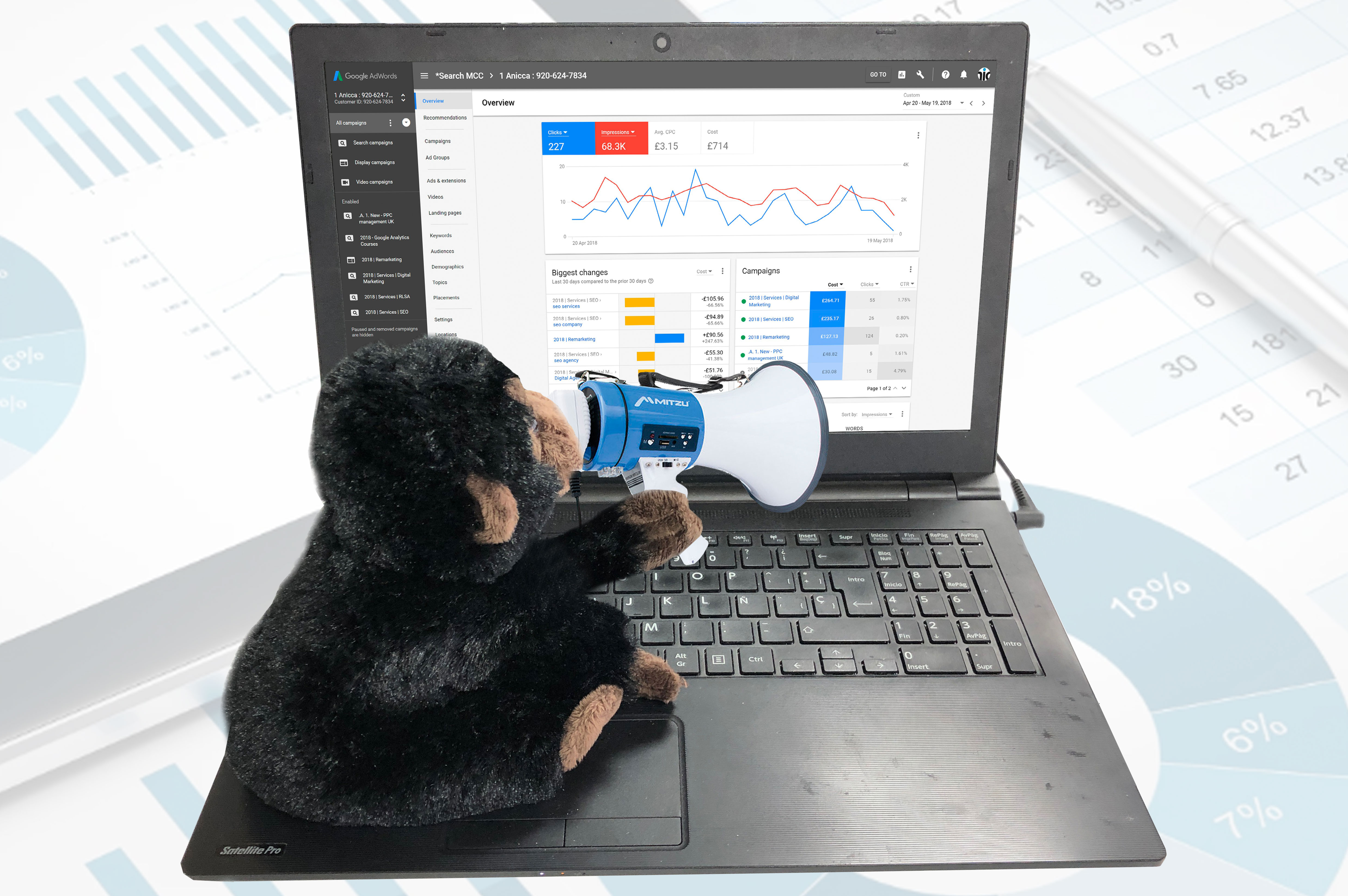In this article, we give you the three indispensable keys when creating an Adwords campaign that is effective and profitable.
1.Know your well target and your product
Needless to say, the first step in creating a Google Adwords campaign is getting to know who you are leading to (the ideal customer or buyer person) and the product that is you want to sell.
Remember: not everything is useful for everyone.
All this will help you to define the type of campaign that can be most effective for this customer and a specific product.
In this previous blog article we were explaining how to create a map of digital empathy that helps you to define your buyer person so you can make sure, before creating the Adwords campaign, who you should address.
In order for the campaign to be profitable, we need every one of these steps to be well-worked:
Campaign for Google Adwords campaign
1 Client looks for product > 2 Campaign keyword activated > 3 Returns a specific ad > 4 Send it to the landing page.

Step 1: The customer looks for your product / service
In this step, we have to be clear how the customer looks for our type of product or service.
We also have to think about how to search Google (what is the question) and what do you expect to find?
Step 2: Activate the keyword
Once we know how our customer or our product or service looks for, we can configure a number of keywords to activate when the customer uses them and our ad appears.
The Digitalmakers Advice:
always have the variants in plurals and masculine and feminine of your keywords, as they may affect the campaign and may not appear if you have not considered it.
Step 3: Google returns a specific ad
Remember that your ad will have to compete (at least) with 2 more ads on the first impact.
Therefore, we need to generate a text that in a few lines makes our product / service stand out above that of the competition.
Here's the great importance of text and write with strategy, as explained in this blog article .
Step 4: Google sends your client to your landing page
Many times, we make the mistake of neglecting landing page to which we will take the client to click ours ad, and then we'll explain why it's important:
In DigitalMakers we always like to emphasize this last step because we believe it is the most important.
Google takes great account of the content the user will find after following the link we've shown to our ad.
Therefore, if you find that the content is not correct or of low quality, it will penalize us with a higher cost per ad or you may even not show it if you consider it not relevant.
Also, think the following:
You have devoted an amount of money that can be high, you have created one or more ads, and you have invested time and money.
What happens if after all this work and money expense do you bring your client to a page that is too general or that is not prepared to accommodate the client according to what he was looking for?
The client will leave your site and your campaign will not have been effective.
You will notice that you have clicks on the ad, but that these have not become Qualified leads, they have not bought your products or have not written you interested in your services.
Therefore, the recommendation of DigitalMakers is that you have a landing page very well prepared and careful before you start your Adwords campaign.
2.Choose the type of campaign that best suits your product
Google has many types of ad campaigns, so we have to choose the one that is most appropriate for our product or service.
There are many options but we can broadly divide them into 3 large groups:
- Search campaigns with text ads
These campaigns define a title, description and link, and where we must first define a number of keywords that will trigger the ad.
In this type of campaign, it is very important to keep in mind that you are sending a direct message to your target, and therefore is vital that copywriting of the message is worked with strategy and totally focused on the end user who reads it.
- Product Search campaigns (shopping)
If what you sell is products, this type of campaign interests you.
Its operation is to link your ecommerce system with that of Google Adwords through a feed product so that we will always have our catalog updated.
This keyword type does not define the keywords because uses the title of the product itself.
When competing with your competitors, identifying elements will be: product name, price and photo.
In case you are a distributor, you must define the name of the product correctly with the exact model, and if it is a product of its own, you can choose to use as a product name part of its characteristics.
The Digitalmakers Advice:
In Google Adwords shopping campaigns, it's really worth working on photos.
All products come through the eyes of your potential customer, and therefore, a good first impression will always make us stand out in front of the competition.
- Remarketing campaigns
This campaign model is a bit different from the other two.
In the remarketing campaigns, the customer visits us first on our website or clicks on a specific product.
From then on, you'll see an ad we've created on a whole host of websites Google has in your Adsense program (as an example, all the news media).
When preparing this remarketing ad, we have to keep in mind that the user has already seen our product but did not buy it, so we have to think about the key factors that can be done, change your mind and finish buying us.
3.Check and refine constantly
At DigitalMakers, we know that a campaign requires maintenance and supervision, and believe that despite having good results in your Adwords campaigns, they can always be better.
If you think you can improve an ad, create a version A and a B and put them to work in parallel.
After a while, analyze which one gets better results and discard the other one.
The Digitalmakers Advice:
Configuring a Google Adwords campaign is not a one-day job, and reviewing it consistently is almost the most important.
We encourage you to track the keywords in your ad, detect new words, mark the negative keywords to avoid them.
In short, what you want is refine your ads to make them the most efficient and profitable for your business.
- Check the price of the auctions
Setting a price per day and by ad is not a guarantee of always having the same results.
Competition also works to overcome us every day, so check the price and adjust it without losing sight of the ROI you expect from your campaign.
- Check negative keywords
Especially at the beginning of the campaign, you will see that there are a whole series of searches for users who skip our ads but that are not really our target because they are not looking for our products / services.
Working with negative keywords is almost more important than keywords, because if you do not do it, much of our daily budget may be escaped without conversions.
- Track your ad's position
The position of an ad and its conversion ratio are based on the same principle as organic searches.
The better your ad is positioned, the better the conversion will get your campaign.
So, check your ROI and define what would be the best position in your case to get the results you want.
But be careful, because not always the first position will give us the best result.
What do we mean by this?
Google's top positions are more expensive, and sometimes appearing in 2nd place gives us less conversions but at a lower price.
What we have to value is what gets us more in mind based on the value of the product so that ROI is as high as possible.
Here's our article on the 3 keys and tips that will help you create a Google Adwords campaign that is profitable and helps you get more leads and benefits.
Subscribe to our blog if you want to receive more articles useful for your business. We're waiting for you!











